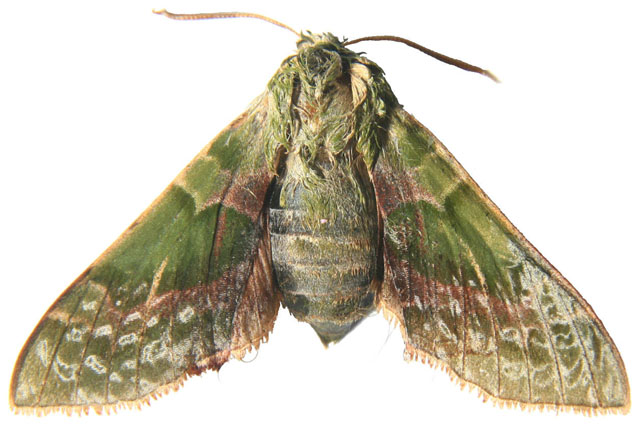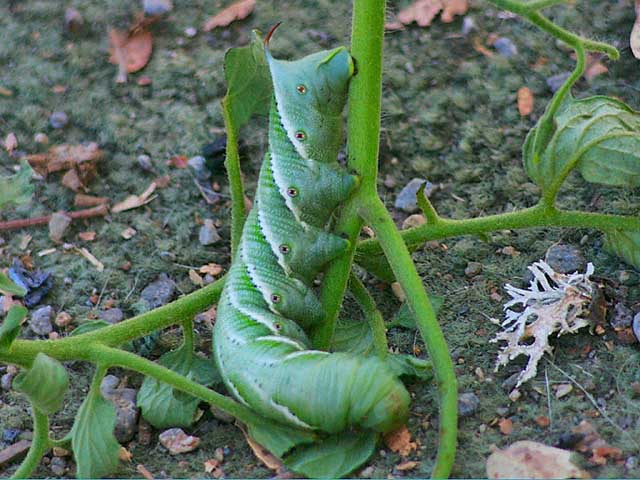Sphinginae subfamily
Sphingini tribe:
 |
This large bodied moth flies in tobacco fields and vegetable gardens
(potatoes, tomatoes) and wherever host plants are found. |
 |
Manduca sexta
WO/RH, the Carolina Sphinx
This species is now recorded in Tehama County by Rodger Harris. If
you grow tomatoes, you might encounter it.
Larvae get very large and can strip a tomato plant. |
 |
Sphinx chersis
USGS, the Northern Ash
Sphinx or Great Ash Sphinx
The upperside of the forewing is soft dark-gray to blue-gray with
a series of black dashes, one reaching the wing tip. Note grey
thorax with narrow black lines.
|
 |
Forewings, long and slender, are held close to the body when the moth
is at rest.
I only see them occasionally on P.E.I. despite visiting lights
frequently. |
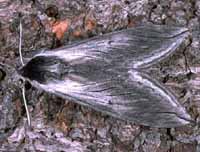 |
Sphinx perelegans
WO, the Elegant Sphinx.
Sphinx perelegans adults fly in montane woodlands and mixed
chaparral-type vegetation as a single brood
in the north, with adults mainly on the wing in June and July.
It flies from dusk until after midnight. Note dark thorax.
|
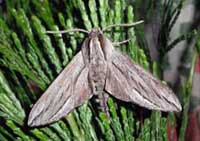 |
This species is not recorded in Tehama County, but it has been see
in Butte County.
Adults fly as a single brood in the desert and in pinyon-juniper
woodland from May to August. |
 |
The upperside of the forewing has a narrow black subterminal line
bordered by a white inverted V-shaped line on the outside, and a
black line running inwards from the apex of the wing.
It is most often found in montane woodlands and along streamcourses.
|
Smerinthini Tribe:
 |
This one is quite similar to Pachysphinx modesta, with modesta
being smaller and darker.
Moths should be on the wing from June-August.
|
 |
The grey-blue eyespot (without a black center pupil) of the hindwing gives this species its name.
Larvae feed on birches, willows, cherries and oaks.
The outer edge of the forewings is quite scalloped. |
 |
This small species might be present. This species ranges across North
America.
The hindwings have a small blue eyespot ringed with black on a yellow
background.
|
 |
Smerinthus cerisyi
WO, the Cerisyi's
Sphinx or One-eyed Sphinx, Larvae feed on poplars and willows.
Flight would be from late May-July as a single brood.
|
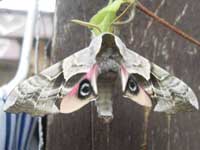 | Larvae feed on poplars, aspen and willows.
Note different shape of double arced forewing pm line compared to the straighter pm line of cerisyi, directly above.
S. ophthalmica has smoother scalloping of the fw outer margin.
|
Macroglossinae subfamily
Dilophonotini Tribe:
 |
The abdomen has very distinct gray and black bands.
Adults nectar at dusk so you may see them in the garen at that time.
possibly a rare stray in late summer |
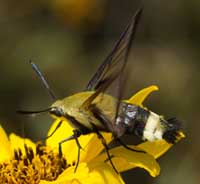 |
Hemaris thetis WO, the Thetis Clearwing or Bee Hawk Moth,
The moth flies along forest edges and in meadows, gardens and
brushy fields. Day-flying adults nectar at lantana, dwarf bush honeysuckle,
snowberry, orange hawkweed, thistles, lilac, Canada violet, etc.
|
Philampelini Tribe:
 |
This moth has been recorded in Tehama County,
and it should be present wherever grapes are found.
Fight would be from June to August. Larvae feed on grape foliage. |
Macroglossini Tribe:
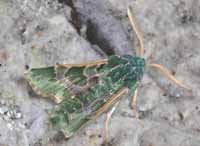 |
Arctonotus lucidus
RH/USGS/HM,
the Pacific Green Sphinx Moth or Bear SphinxThis species is
confirmed in Tehama
County by Rodger Harris, January 9, 2007.
It tends to be
an early winter-early spring flier, on the wing in the early
evening. It comes to lights at night. |
Arctonotus lucidus, Red Bluff, January 23, 2012, early evening, Hillary Medellin
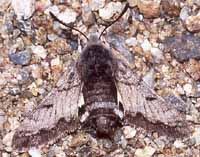 |
Adults nectar at flowers during the warm parts of the day.
Euproserpinus phaeton adults fly swiftly and close to the ground over
dry washes and flat areas in deserts as a single brood from
February-April. very unlikely
|
 |
Hyles lineata
WO,
the White-lined Sphinx
Adults usually fly at dusk, during the night, at dawn, and during the
day. Moths nectar at salvia and oviposit on Epilobium cana
(California fuchsia) and Hooker's Evening Primrose. |
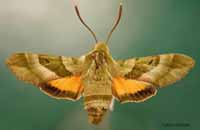 |
Adults fly in the afternoon from April-June in oak woodland and
pine-oak woodland in foothills, nectaring from chia, heartleaf
milkweed, golden currant, bluedicks, fairyfans, vetches,
thistles, hedgenettles, etc. |
|
|
